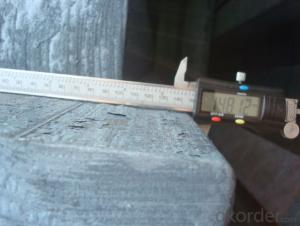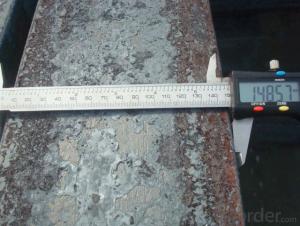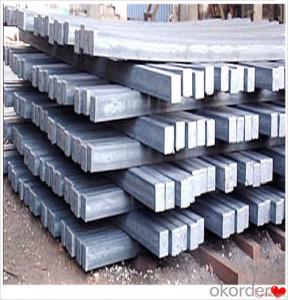Prime Hot Rolled Square Steel Billet for sale
- Loading Port:
- China main port
- Payment Terms:
- TT or LC
- Min Order Qty:
- 1000 m.t.
- Supply Capability:
- 10000 m.t./month
OKorder Service Pledge
OKorder Financial Service
You Might Also Like
Product Description:
OKorder is offering Prime Hot Rolled Square Steel Billet for sale at great prices with worldwide shipping. Our supplier is a world-class manufacturer of steel, with our products utilized the world over. OKorder annually supplies products to African, South American and Asian markets. We provide quotations within 24 hours of receiving an inquiry and guarantee competitive prices.
Product Applications:
Prime Hot Rolled Square Steel Billet for sale ideal for structural applications and are widely used in the construction of buildings and bridges, and the manufacturing, petrochemical, and transportation industries.
Product Advantages:
OKorder's Prime Hot Rolled Square Steel Billet for sale are durable, strong, and wide variety of sizes.
Main Product Features:
· Premium quality
· Prompt delivery & seaworthy packing (30 days after receiving deposit)
· Can be recycled and reused
· Mill test certification
· Professional Service
· Competitive pricing
Product Specifications:
Manufacture: Hot rolled
Grade: Q195/Q235/Q275/20MnSi
Certificates: ISO, SGS, BV
size:60*60/90*90/100*100/120*120/150*150
Length: 6m/12m,
Packaging: Export packing, nude packing, bundled
Standard | C(%) | Mn(%) | S(%) | P(%) | Si(%) |
20MnSi | 0.17-0.25 | 1.2-1.6 | ≤ 0.050 | ≤ 0.050 | 0.40-0.80 |
FAQ:
Q1: Why buy Materials & Equipment from OKorder.com?
A1: All products offered byOKorder.com are carefully selected from China's most reliable manufacturing enterprises. Through its ISO certifications, OKorder.com adheres to the highest standards and a commitment to supply chain safety and customer satisfaction.
Q2: How do we guarantee the quality of our products?
A2: We have established an advanced quality management system which conducts strict quality tests at every step, from raw materials to the final product. At the same time, we provide extensive follow-up service assurances as required.
Q3: How soon can we receive the product after purchase?
A3: Within three days of placing an order, we will arrange production. The normal sizes with the normal grade can be produced within one month. The specific shipping date is dependent upon international and government factors, the delivery to international main port about 45-60days.
Images:


- Q:How are steel billets marked for identification?
- Steel billets are typically marked for identification using a variety of methods such as stamping, engraving, or laser marking. This allows for important information like the grade, size, and batch number to be permanently etched onto the surface of the billet, ensuring easy identification and traceability throughout the manufacturing process.
- Q:How are steel billets used in the production of crankshafts?
- Steel billets are an essential component in the production of crankshafts. A crankshaft is a vital part of an engine that converts the reciprocating motion of the pistons into rotational motion, thus providing power to the vehicle or machinery. The manufacturing process of crankshafts involves several steps, and steel billets play a crucial role in forming the base material for this intricate component. A steel billet is a semi-finished product, typically in a square or rectangular shape, which is obtained through the continuous casting or rolling of molten steel. To produce a crankshaft, the steel billet is first heated to a specific temperature, usually through induction heating, to enhance its malleability and make it easier to shape. The heated billet is then placed into a forging machine, where it undergoes a series of compressive forces and plastic deformation to gradually form the desired shape of the crankshaft. During the forging process, the steel billet is subjected to immense pressure to ensure that the metal grain structure aligns in the optimal direction, resulting in a stronger and more durable crankshaft. The precise shaping of the crankshaft's main bearing journals, crankpin journals, and counterweights is achieved through carefully controlled forging techniques. Once the forging process is complete, the partially finished crankshaft undergoes various machining operations, including milling, turning, and grinding, to refine its dimensions and surface finish. These operations help ensure the crankshaft meets the required specifications for smooth operation and efficient power transmission. In summary, steel billets serve as the raw material for crankshaft production. Through the forging process, the billet is shaped and transformed into a strong and resilient crankshaft that can withstand the demanding conditions of an engine. The use of steel billets helps produce crankshafts with superior strength, durability, and performance, making them a critical component in the automotive and machinery industries.
- Q:What is the process of heat treatment for steel billets?
- The process of heat treatment for steel billets involves heating the billets to a specific temperature, typically above the transformation temperature, followed by controlled cooling. This process helps to modify the microstructure of the steel, improving its mechanical properties such as strength and toughness. Different heat treatment techniques, such as annealing, quenching, and tempering, are used to achieve desired material properties for specific applications.
- Q:How are steel billets used in the manufacturing of furniture and fixtures?
- Steel billets are used in the manufacturing of furniture and fixtures as they serve as the raw material for various components. These billets are shaped, cut, and molded to create the desired parts and structures, such as frames, legs, and supports. The high strength and durability of steel make it a popular choice for furniture and fixture manufacturing, ensuring long-lasting and sturdy products.
- Q:What are the common applications of stainless steel billets?
- Stainless steel billets are widely used in various industries due to their exceptional properties and versatility. Some of the common applications of stainless steel billets include: 1. Construction: Stainless steel billets are extensively used in the construction industry for structural purposes. They are used to manufacture beams, columns, and other load-bearing components due to their high strength and corrosion resistance. 2. Automotive Industry: Stainless steel billets find applications in the automotive industry for manufacturing various components like exhaust systems, engine parts, and suspension components. The high temperature and corrosion resistance of stainless steel make it an ideal choice for these applications. 3. Aerospace Industry: Stainless steel billets are used in the aerospace industry to manufacture critical components like aircraft frames, landing gear, and engine parts. The high strength-to-weight ratio and resistance to extreme temperatures make stainless steel a preferred material in this sector. 4. Oil and Gas Industry: Stainless steel billets are widely used in the oil and gas industry due to their excellent corrosion resistance. They are used to manufacture pipes, fittings, valves, and other equipment that come in contact with corrosive fluids or gases. 5. Food Processing Industry: Stainless steel billets are extensively used in the food processing industry due to their hygienic properties and resistance to corrosion caused by food and cleaning agents. They are used to manufacture equipment like storage tanks, conveyors, and processing machinery. 6. Medical and Pharmaceutical Industry: Stainless steel billets find applications in the medical and pharmaceutical industry for manufacturing surgical instruments, implants, and equipment. The biocompatibility and sterilization capabilities of stainless steel make it suitable for these critical applications. 7. Marine Industry: Stainless steel billets are used in the marine industry for manufacturing various components like ship hulls, propellers, and fittings. The corrosion resistance of stainless steel is crucial in the harsh saltwater environment. 8. Power Generation Industry: Stainless steel billets are used in power plants for manufacturing boilers, heat exchangers, and turbine components. The high-temperature and corrosion resistance properties of stainless steel make it suitable for these demanding applications. In summary, stainless steel billets have a wide range of applications across industries due to their exceptional properties like strength, corrosion resistance, and temperature resistance. From construction and automotive to aerospace and medical sectors, stainless steel billets play a vital role in manufacturing critical components and equipment.
- Q:What are the different production methods for steel billets?
- There are several different production methods for steel billets, including continuous casting, ingot casting, and direct hot rolling. Continuous casting involves pouring molten steel into a water-cooled mold to form a continuous strand, which is then cut into desired lengths. Ingot casting involves pouring molten steel into individual molds to form solid blocks, which are later reheated and rolled into billets. Direct hot rolling involves passing a large steel ingot through a series of rolling mills to reduce its size and shape it into a billet.
- Q:What are the physical properties of steel billets?
- Steel billets possess various physical properties that render them highly suitable for a multitude of industrial applications. Primarily, they exhibit a remarkable strength-to-weight ratio, ensuring impeccable structural integrity and the ability to endure heavy loads without deformation or breakage. Another significant physical attribute of steel billets lies in their hardness. Steel is renowned for its hardness, which grants it resistance against wear and tear. Consequently, steel billets prove to be ideal for sectors where durability and long-term performance are of utmost importance, such as construction, automotive, and machinery industries. Furthermore, steel billets boast a lofty melting point, enabling them to withstand extreme heat without deformation or liquefaction. This trait proves indispensable in applications involving high temperatures, such as the manufacturing of tools, machinery, and equipment within the aerospace and energy sectors. Additionally, steel billets exhibit exceptional ductility and malleability, facilitating their effortless manipulation into diverse structures and products. This adaptability makes steel billets highly versatile and amenable to various manufacturing processes, including rolling, forging, and extrusion. Moreover, steel billets demonstrate commendable electrical and thermal conductivity, rendering them suitable for applications that necessitate efficient heat transfer and electrical conduction. These properties hold particular value in the production of electrical wiring, power transmission lines, and heat transfer equipment. In conclusion, steel billets possess key physical properties encompassing high strength, hardness, melting point, ductility, malleability, and conductivity. These attributes enable their utilization across a wide range of industries and applications, where their exceptional performance and reliability are indispensable.
- Q:How do steel billets contribute to the overall thermal insulation of a structure?
- Steel billets do not contribute to the overall thermal insulation of a structure. In fact, steel is a good conductor of heat and can transfer heat quickly, making it a poor choice for thermal insulation.
- Q:What are the different types of steel billet casting processes?
- There are several different types of steel billet casting processes, including continuous casting, semi-continuous casting, and ingot casting. Continuous casting involves the continuous pouring of molten steel into a water-cooled mold, allowing for a continuous production process. Semi-continuous casting, on the other hand, involves the periodic pouring of molten steel into individual molds, resulting in intermittent production. Ingot casting is a traditional method where molten steel is poured into a stationary mold, allowing it to solidify into a solid block or ingot shape. These different casting processes offer various advantages and are utilized based on the specific requirements of the steel production industry.
- Q:Refinery carbon 3 is propane, then carbon four carbon five is what name ah?.What are they used for?
- Carbon four is butane, C4H10 carbon five is pentane C5H12
1. Manufacturer Overview |
|
|---|---|
| Location | |
| Year Established | |
| Annual Output Value | |
| Main Markets | |
| Company Certifications | |
2. Manufacturer Certificates |
|
|---|---|
| a) Certification Name | |
| Range | |
| Reference | |
| Validity Period | |
3. Manufacturer Capability |
|
|---|---|
| a)Trade Capacity | |
| Nearest Port | |
| Export Percentage | |
| No.of Employees in Trade Department | |
| Language Spoken: | |
| b)Factory Information | |
| Factory Size: | |
| No. of Production Lines | |
| Contract Manufacturing | |
| Product Price Range | |
Send your message to us
Prime Hot Rolled Square Steel Billet for sale
- Loading Port:
- China main port
- Payment Terms:
- TT or LC
- Min Order Qty:
- 1000 m.t.
- Supply Capability:
- 10000 m.t./month
OKorder Service Pledge
OKorder Financial Service
Similar products
New products
Hot products
Hot Searches
Related keywords





























